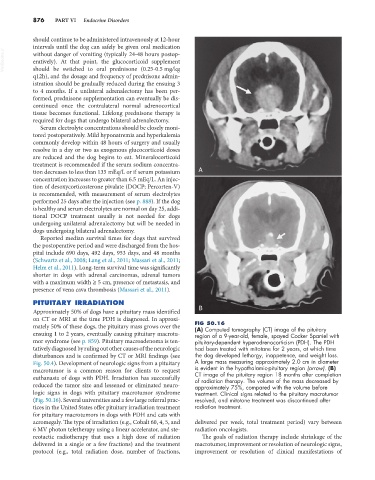Page 904 - Small Animal Internal Medicine, 6th Edition
P. 904
876 PART VI Endocrine Disorders
should continue to be administered intravenously at 12-hour
intervals until the dog can safely be given oral medication
VetBooks.ir without danger of vomiting (typically 24-48 hours postop-
eratively). At that point, the glucocorticoid supplement
should be switched to oral prednisone (0.25-0.5 mg/kg
q12h), and the dosage and frequency of prednisone admin-
istration should be gradually reduced during the ensuing 3
to 4 months. If a unilateral adrenalectomy has been per-
formed, prednisone supplementation can eventually be dis-
continued once the contralateral normal adrenocortical
tissue becomes functional. Lifelong prednisone therapy is
required for dogs that undergo bilateral adrenalectomy.
Serum electrolyte concentrations should be closely moni-
tored postoperatively. Mild hyponatremia and hyperkalemia
commonly develop within 48 hours of surgery and usually
resolve in a day or two as exogenous glucocorticoid doses
are reduced and the dog begins to eat. Mineralocorticoid
treatment is recommended if the serum sodium concentra-
tion decreases to less than 135 mEq/L or if serum potassium A
concentration increases to greater than 6.5 mEq/L. An injec-
tion of desoxycorticosterone pivalate (DOCP; Percorten-V)
is recommended, with measurement of serum electrolytes
performed 25 days after the injection (see p. 888). If the dog
is healthy and serum electrolytes are normal on day 25, addi-
tional DOCP treatment usually is not needed for dogs
undergoing unilateral adrenalectomy but will be needed in
dogs undergoing bilateral adrenalectomy.
Reported median survival times for dogs that survived
the postoperative period and were discharged from the hos-
pital include 690 days, 492 days, 953 days, and 48 months
(Schwartz et al., 2008; Lang et al., 2011; Massari et al., 2011;
Helm et al., 2011). Long-term survival time was significantly
shorter in dogs with adrenal carcinomas, adrenal tumors
with a maximum width ≥ 5 cm, presence of metastasis, and
presence of vena cava thrombosis (Massari et al., 2011).
PITUITARY IRRADIATION
Approximately 50% of dogs have a pituitary mass identified B
on CT or MRI at the time PDH is diagnosed. In approxi-
mately 50% of these dogs, the pituitary mass grows over the FIG 50.16
(A) Computed tomography (CT) image of the pituitary
ensuing 1 to 2 years, eventually causing pituitary macrotu- region of a 9-year-old, female, spayed Cocker Spaniel with
mor syndrome (see p. 859). Pituitary macroadenoma is ten- pituitary-dependent hyperadrenocorticism (PDH). The PDH
tatively diagnosed by ruling out other causes of the neurologic had been treated with mitotane for 2 years, at which time
disturbances and is confirmed by CT or MRI findings (see the dog developed lethargy, inappetence, and weight loss.
Fig. 50.4). Development of neurologic signs from a pituitary A large mass measuring approximately 2.0 cm in diameter
macrotumor is a common reason for clients to request is evident in the hypothalamic-pituitary region (arrow). (B)
CT image of the pituitary region 18 months after completion
euthanasia of dogs with PDH. Irradiation has successfully of radiation therapy. The volume of the mass decreased by
reduced the tumor size and lessened or eliminated neuro- approximately 75%, compared with the volume before
logic signs in dogs with pituitary macrotumor syndrome treatment. Clinical signs related to the pituitary macrotumor
(Fig. 50.16). Several universities and a few large referral prac- resolved, and mitotane treatment was discontinued after
tices in the United States offer pituitary irradiation treatment radiation treatment.
for pituitary macrotumors in dogs with PDH and cats with
acromegaly. The type of irradiation (e.g., Cobalt 60, 4, 5, and delivered per week, total treatment period) vary between
6 MV photon teletherapy using a linear accelerator, and ste- radiation oncologists.
reotactic radiotherapy that uses a high dose of radiation The goals of radiation therapy include shrinkage of the
delivered in a single or a few fractions) and the treatment macrotumor, improvement or resolution of neurologic signs,
protocol (e.g., total radiation dose, number of fractions, improvement or resolution of clinical manifestations of

